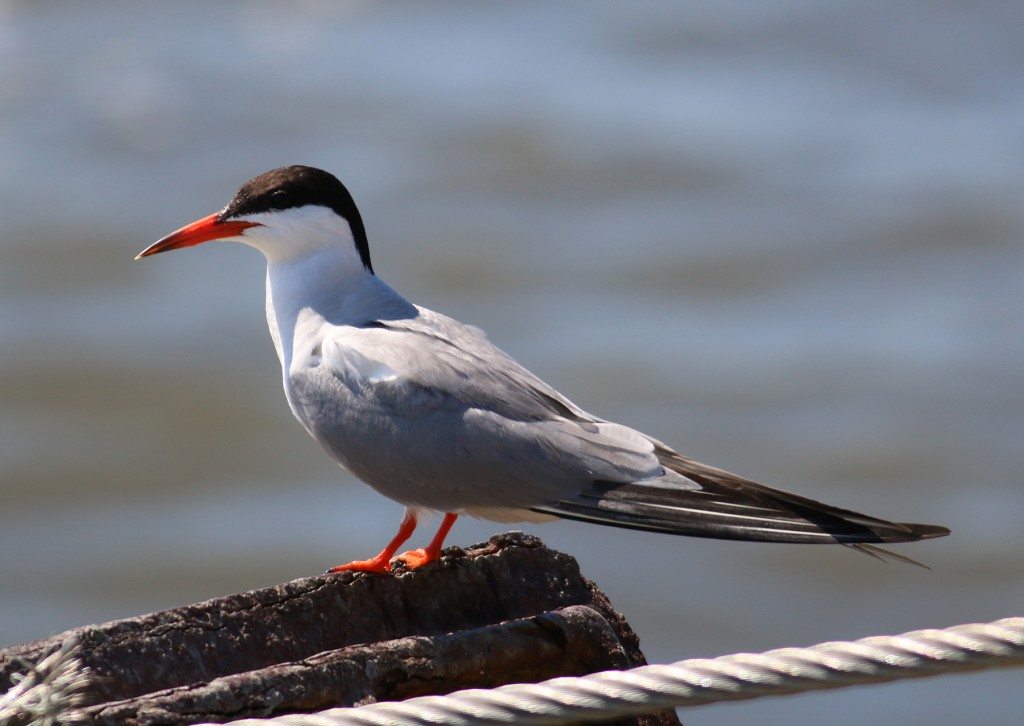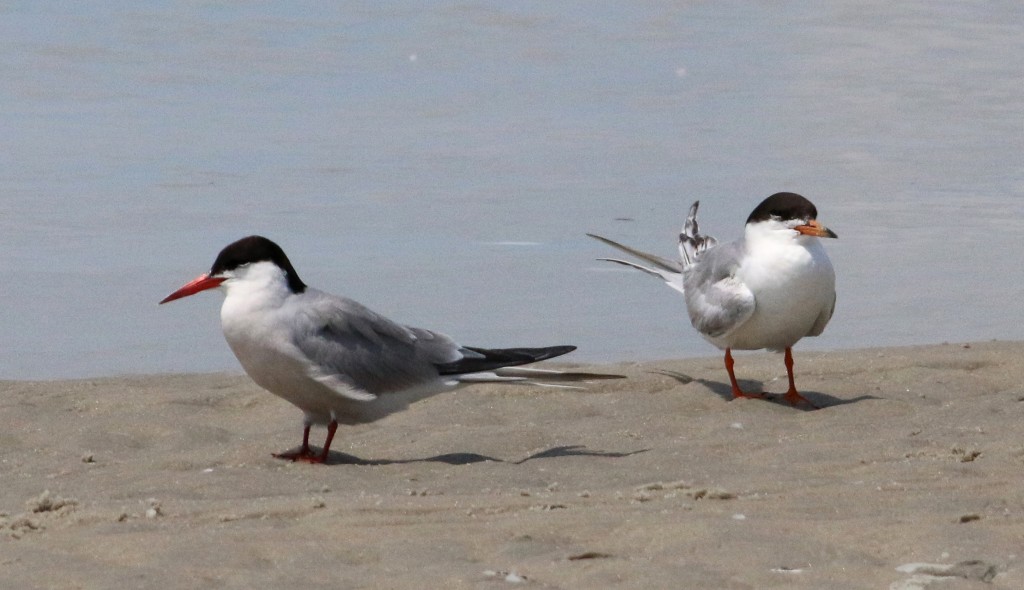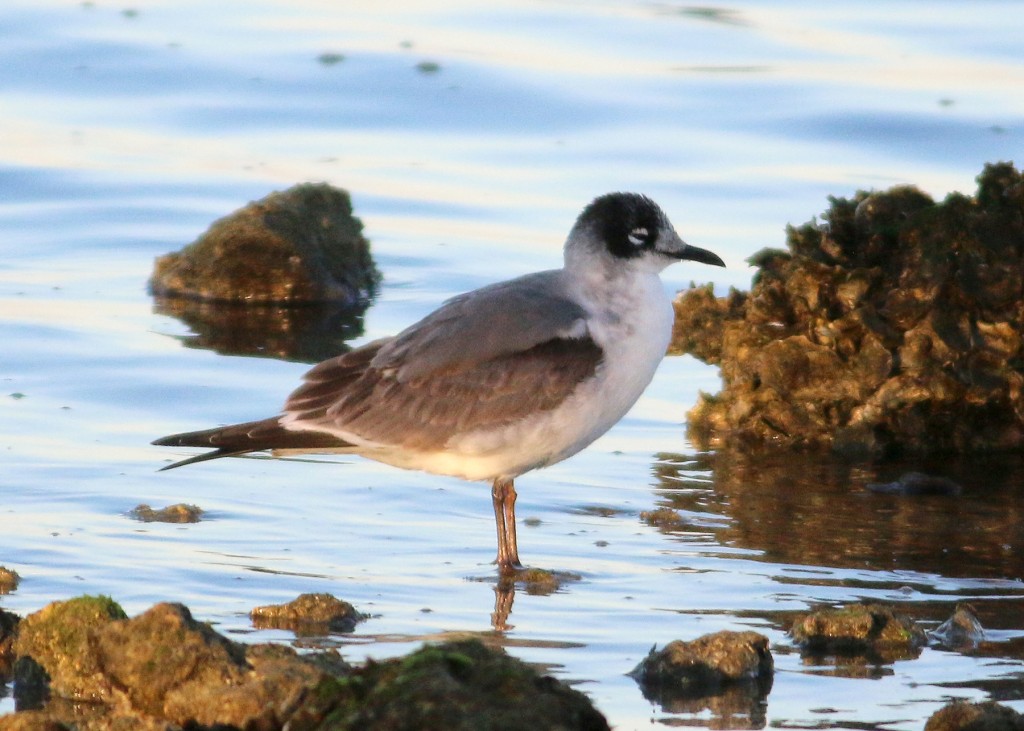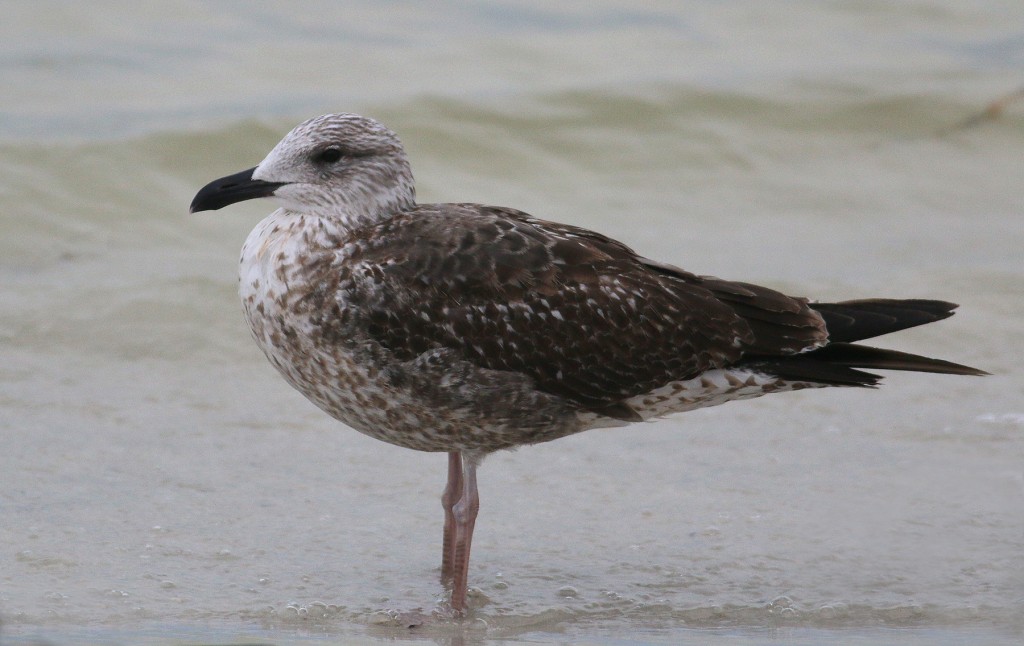OK, you’re out birding and you see the excellent individual shown above. Many birders will be able to recognize this bird as one of the medium-sized terns, which here in the eastern US narrows down to Forster’s or Common Tern. But which is it? For far too many birders, this is a tough call. Like many birders, I struggled with these terns for a long, long time. For FAR too long, I felt like I was just guessing when I saw a medium-sized tern, hoping that the habitat would push the odds in my favor (Forster’s Terns prefer marshes, while Common Terns prefer beaches). That was frustrating to me because bird identification should be based on observation of specific features and shouldn’t feel like a coin toss. Well, this year I decided to do something about it and worked at trying develop confidence in identifying these species correctly. (Actually, although I say that I worked at it, that’s not completely true, since this minor quest became an utter pleasure and was the furthest thing from work.) Today I will share some of my thoughts on distinguishing these two species in the hope that my experience might help some of you.
OK, to start us off, let’s admit that distinguishing Common and Forster’s Terns is one of the more challenging bird pair identifications. Don’t expect it to be entirely clear, especially when starting out. So what do the field guides tell us to look for on these terns? Well, Forster’s Tern is supposed to have a light orange bill, whiter body and wings, a tail that extends beyond the folded wingtips, and longer legs, while Common Tern sports a deeper orange bill, gray body and darker wings, a tail extending the same length as the wingtips, and with black on its outermost tail feathers. Although all of those points are indeed true, for me they were either difficult to distinguish in the field (Is that bill light orange or deep orange? Is that body gray or does it just look gray because it is shaded from the sun?), or they were difficult to see (the edging on the tail feathers is seldom apparent even in good lighting, and only in flight). Far too often my decision changed depending on the lighting conditions; a bird would look like it had a gray body in flight, having me lean toward Common, and then it banked toward the sun and miraculously it was transformed into a white-bodied Forster’s. Drat. The same thing happened when trying to decide how orange the bill was; a well-lit bill could look light orange (perfect for a textbook Forster’s), and then when the head turned and the bill became shaded, it was suddenly the deep orange bill of a Common Tern. Ugh. I was ready to wave the white flag and surrender.
Now after observing several hundreds of these birds this summer, often in locations where both species are found intermixed, I feel like I’ve finally broken through. Part of the reason is purely the additional experience, and partly its because now I’ve found identification points that work for me. When the birds are resting on a beach or mudflat, I now focus on two features: the color of the folded wingtips and the bill color. For me the folded wingtips are actually more reliable, with the Common Tern having black wingtips and the Forster’s Tern having grayish wingtips. Look at the terns in the photos below and decide purely on the wingtips and you should come to the correct conclusion.
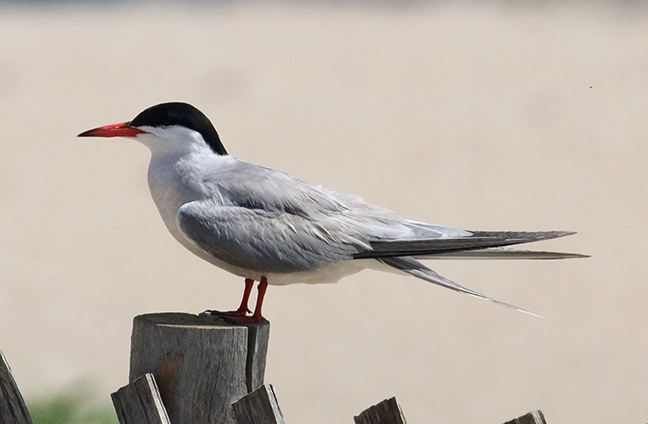
If we start with the bill color, I would have a hard time deciding if this is a Forster’s or Common Tern, perhaps leaning slightly and uncomfortably towards the darker bill of a Common Tern. But look at the wingtips…they are jet black, unmistakably characteristic of Common Tern.
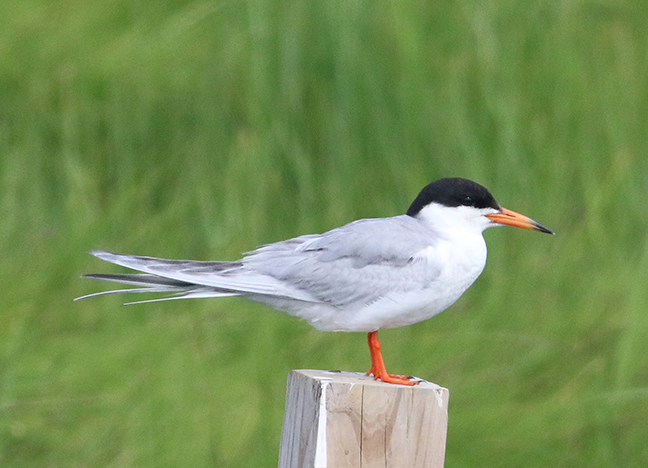
Which tern is it? Start with the folded wingtips. In this bird the wingtips are gray, pointing towards Forster’s. The lighter orange bill compared to the previous photo of the Common Tern confirms the conclusion.
Of course, it helps that in these photos the birds are in nearly perfect lighting and in the textbook profile pose, but we have to start somewhere. For me the bill color is somewhat debatable, but the wingtips aren’t, and using the combination of both leads to a much more reliable conclusion. To put further icing on the cake, when both species are present together, the comparisons are easier and allow us to introduce one more feature: leg length. Look at the two terns in the photo below and decide what you think they are. Then look at the leg length. Does one of the birds have longer legs than the other?
When they are side-by-side like this, things get easier; the bird on the left has a deep orange bill and black wingtips (= Common Tern), and the one on the right has a lighter orange bill and gray wingtips (= Forster’s Tern). But note the leg length; the Common Tern has shorter legs than the Forster’s, just like the field guides say. Leg length is hard to judge when they are not closely juxtaposed like this, but can be another supporting feature to look for in mixed flocks.
So that’s what I focus on with resting birds. How about when they are in flight? At times this can also be surprisingly easy. I used to look at the undersides of the bird…the body and wings, whereas now I focus on the upper surface of the wings. For me, looking at the lower wing surface or body was frustrating because it was so dependent upon lighting, and with the sun being above, these areas alternated between sun and shade during flight, turning identification into a guessing game. The upperwings are more often well-lit, thereby allowing for more reliable views. Common Terns have upper wing surfaces that are almost uniformly gray, with a fairly large wedge of black that encompasses at least the five outermost primary wing tips. The upper wings of Forster’s Terns, on the other hand, are two-toned or three-toned, with the distal half of the wing (furthest from the body) being distinctly whiter than the half that is closest to the body, which is gray. There is also a smaller patch of black on the outermost upper wing tips. So instead of trying to determine if the wings are light gray or dark grey (are they kidding?), try to determine if the gray is uniform or two-toned. With practice, you will find that you often can distinguish these two species at a surprising distance by focusing on the upper wing surface. Give it a try. Compare the photos of soaring birds below.
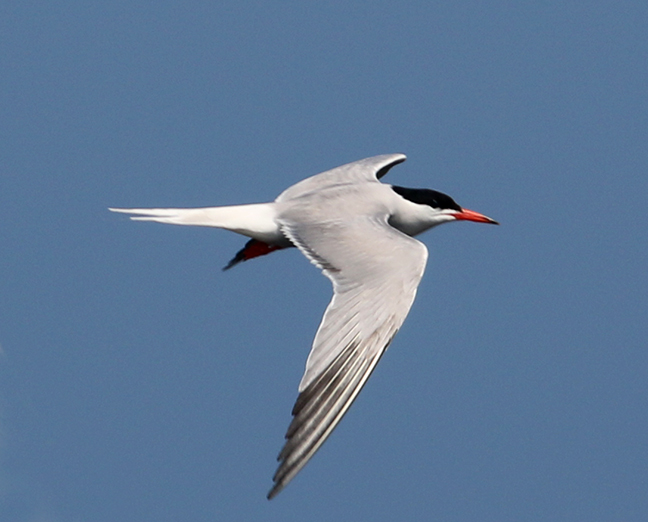
Classic view of a Common Tern in flight. Note that the upper wing is uniformly gray both before and after the ‘elbow’. There is also a fairly extensive black wedge at the wing tips.
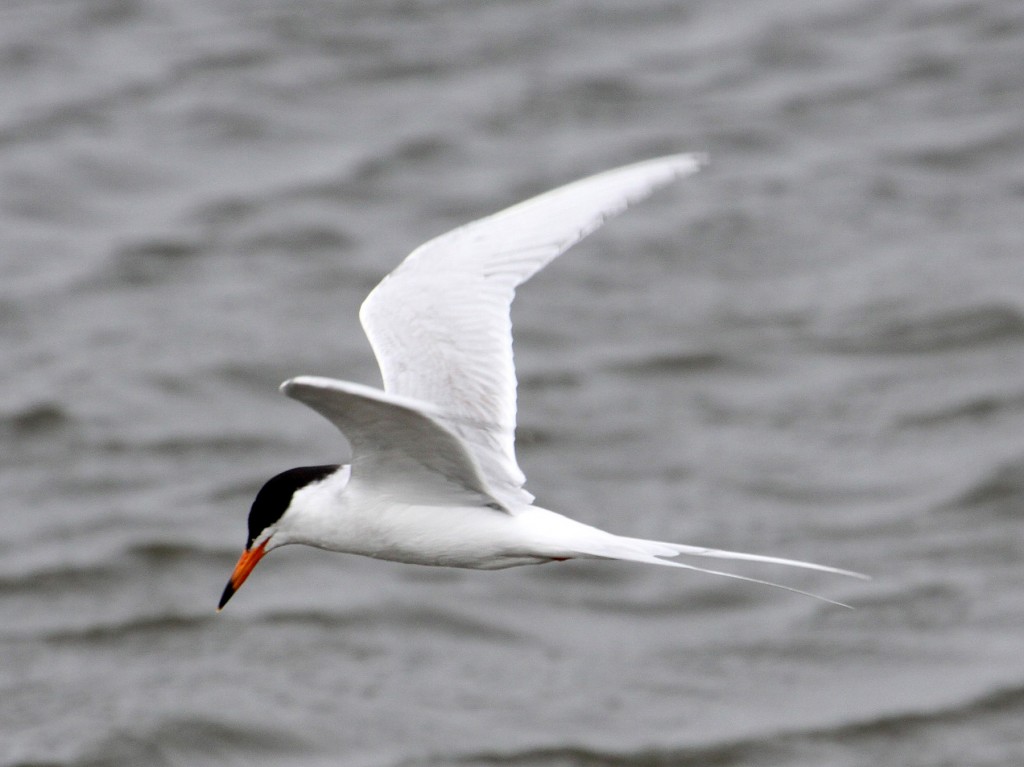
Forster’s Tern in flight. Note the relative lack of any black at the tip of the upper wings. The distal half of the wings beyond the ‘elbow’ are typically whiter than the proximal half, but its not so obvious in this slightly overexposed view.
One of the interesting things about Common and Forster’s Terns is that (unlike many other species) they are actually easier to identify when they are juveniles or are in non-breeding plumage. Forster’s Terns have a dark patch that is limited to the area immediately surrounding the eye, making them look like they just lost a boxing match, while Common Terns have a black patch that extends from the rear of the eye to the hind neck. Conveniently, in juveniles and in non-breeding plumage, Common Terns also contain a black ‘carpal bar’ on their wings that Forster’s Terns lack.
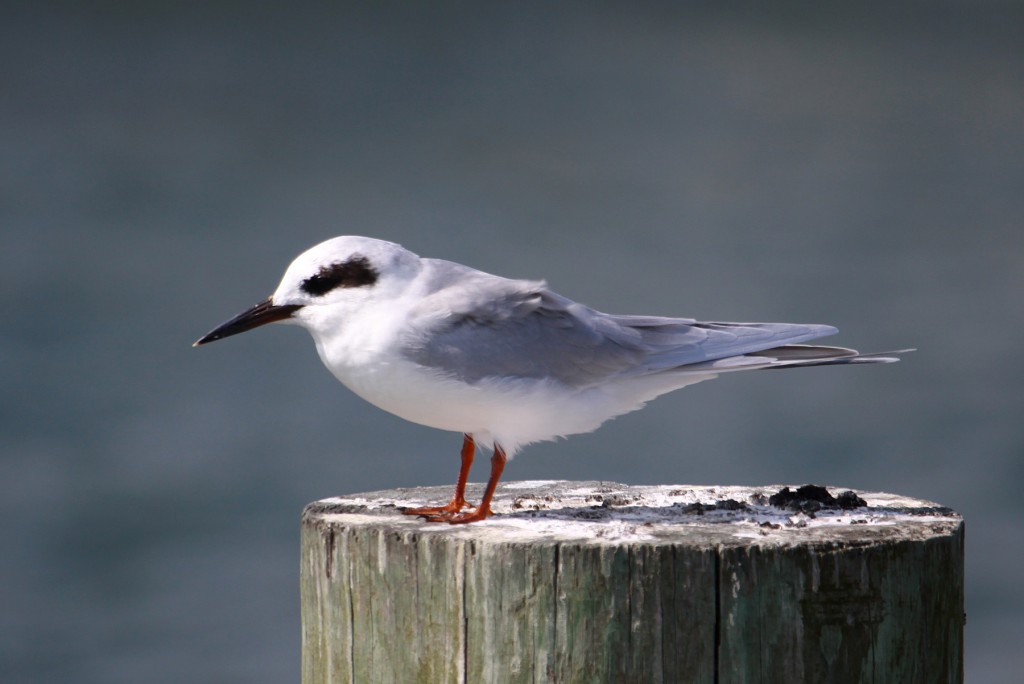
Forster’s Tern in fall. The restriction of the dark patch to the eye and the lack of a carpal patch both point to Forster’s.
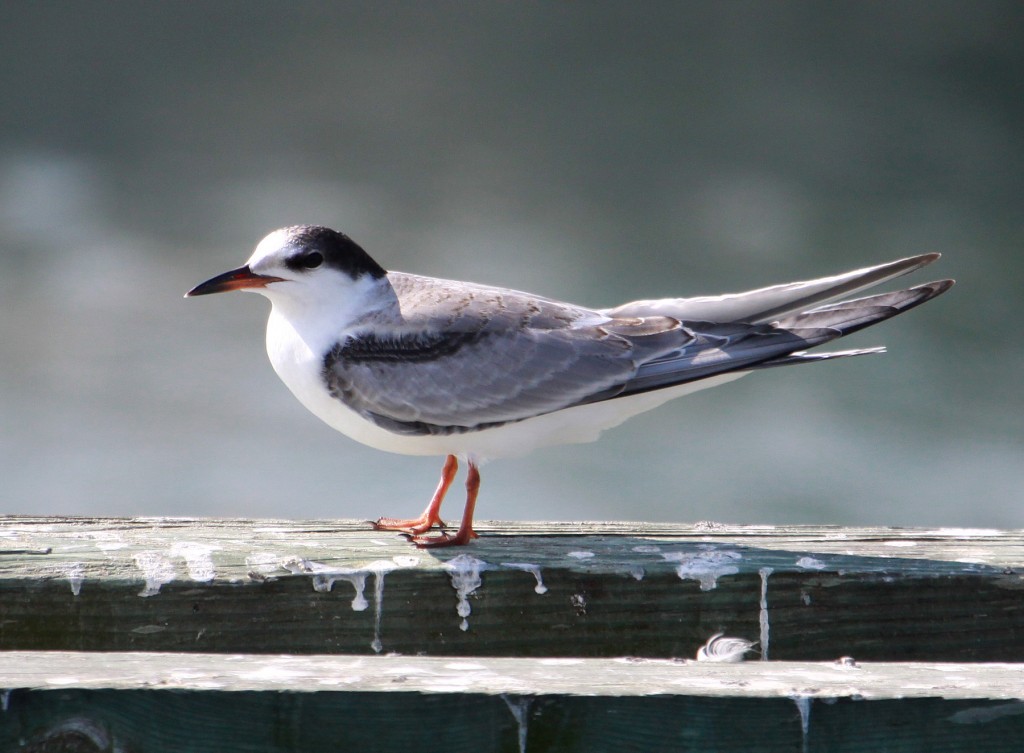
Common Tern in fall. Note the black patch on the hindneck, not surrounding the eye, and the presence of the diagnostic carpal bar on the wing.
Both species will have juvenile plumage that has additional touches of brown or ginger when they are extremely young in early summer, but the diagnostic black facial patches are present throughout their first year. The brown or ginger portions of the wing and body plumage wear away by late summer, leaving the mostly silvery late fall plumage shown above.
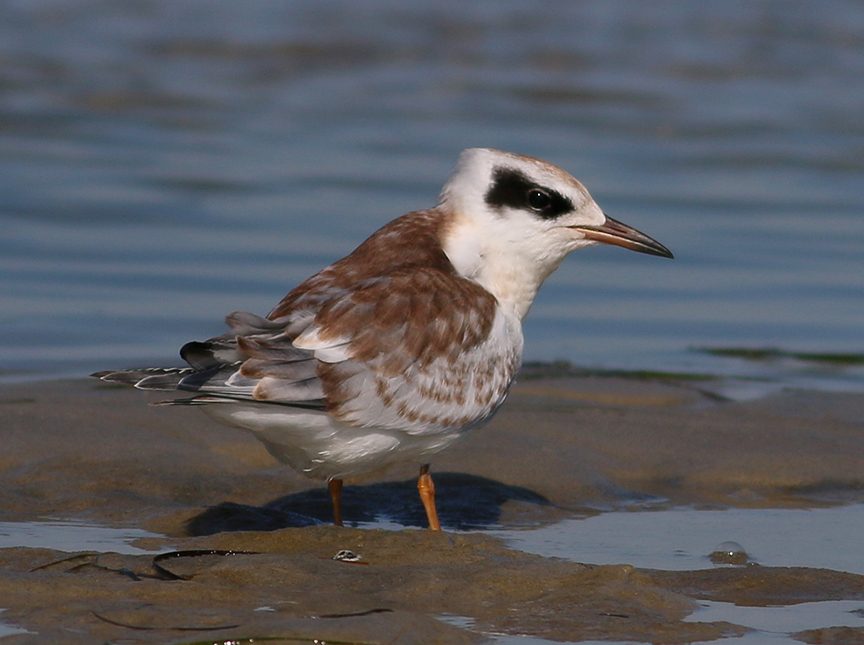
Here’s a juvenile Forster’s Tern. The black eyepatch indicates that its a Forster’s. The ginger color on its body and wings is on the edge of its feathers. Those ginger tips will eventually wear off, leaving the silvery pattern that we saw above. Photo kindly provided by Karmela Moneta.
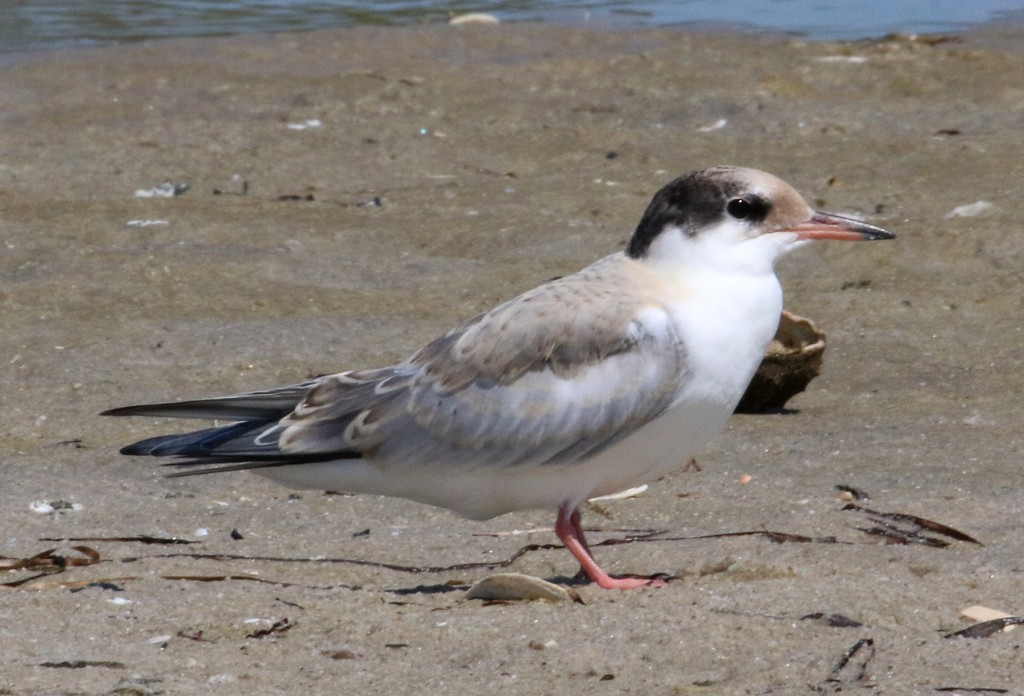
Here is an immature Common Tern in late July for comparison. Note the different pattern in the face compared with the immature Forster’s Tern. The dark ‘carpal patch’ is somewhat visible underneath some feathers. Later in the season this patch becomes much more visible as the overlying feather tips wear away.
During the mid-to-late summer, the presence of these juvenile birds greatly helps to identify the adults. If you find yourself by a large tern flock, watch for begging youngsters, which should be readily identifiable based on the black eye or neck patches, and see if you can identify the parents when they arrive to feed the young. Then watch the parents when they leave to see if you could identify them in flight. I found this kind of conformation and reinforcement to be extremely valuable.
There are a few other identification points that can be helpful, but their use is more limited than the ones discussed above. Forster’s Terns molt a little earlier in the season than Common Tern, so birds that are losing their black cap in July are likely to be Forster’s, whereas those retaining their full black caps in late August are more likely to be Common. This can vary between individuals, but can be fun to follow. Finally, the tail can extend considerably further than the folded wingtips of Forster’s Terns, but this is most easily seen early in the year. Those wingtips will wear away and become shorter as the season progresses and then becomes an unreliable indicator.
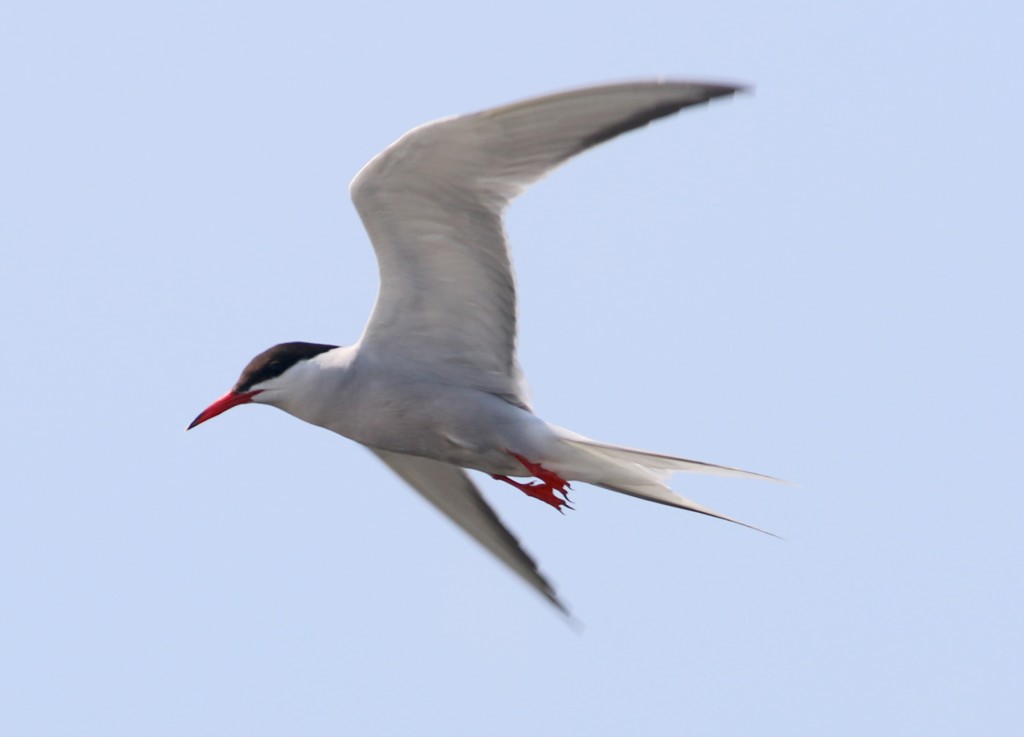
A final identification point that can be helpful. The outer tail feathers of Common Tern are partially black whereas in Forster’s they are all white. This is usually difficult to see but is fun to look for.
Now that you’ve read this far, I want to point out that despite having all of these identification points, distinguishing these two species still can be difficult. These terns take at least two years to mature, resulting in fully mature birds mixing with first-year birds, they have complex molt patterns, and the brightness of the plumage can change during the year depending on feather wear. Good luck using these identification points. And then we can start working on shorebirds!
ps…in case you haven’t figured it out, the bird in the uppermost photo at the beginning of this post is a Common Tern.
